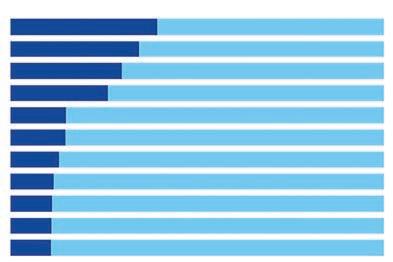
2 minute read
Gender data shows construction still has work to do
Construction has worked hard to attract more females into the industry. Ahead of International Women’s Day, Kris Hudson looks at whether this is working
The construction industry will be marking International Women’s Day this month with a degree of celebration, but also keen awareness that there remains a lot more to be done to achieve greater diversity across the sector.
Advertisement
Construction as a whole continues to lag significantly behind other industries. Based on data from the Office of National Statistics from the third quarter of last 2022, women make up 47.6% of the overall UK workforce. When employment is broken down by industry, construction sits last, with only 14.7% of those employed in the industry being women, 32.9 percentage points lower than the UK average (see chart top right).
The industry can take some comfort that progress has nonetheless been made and the trend is moving – slowly – in the right direction. Over the last 10 years the number of women as a proportion of the overall construction workforce has increased by 36.9% (see chart centre right).
The trend is moving – slowly – in the right direction. Over the last 10 years the number of women as a proportion of the overall construction workforce has increased by 36.9%
These data sets are important to help industry leaders understand the direction of travel and they underscore the work that is still to be done. However, it’s important to understand their limitations. Most importantly, these statistics only cover a narrow range of constructionrelated work based on the Standard Industry Classification (SIC) 2007 definitions. They don’t cover related professions within the delivery of construction work.
The picture of construction and development-related professional services and management roles is overall more positive. Here 39.4% of architectural and town planning technicians are women, compared to 34.5% of town planning officers, and 29.9% of those in estimation, valuation and assessment roles (see chart bottom right).
The available data reinforces that the industry needs to keep focusing on the issue of diversity.
As the nature of construction work gets more complex with new tools and ways of working, alongside a persistent labour shortage, attracting a diverse and inclusive talent pool becomes ever more important.
The best and brightest should see a future in construction and, with the sector needing to form the backbone of a greener and more productive society, tapping into this diverse pool of potential will be vital.
Percentage of women employed in construction, 32.9 points lower than the UK average 14.7

Human health & social activities Education Accommodation & food services Other services Public admin & defence; social security Real estate activities Wholesale, retail & repair of motor vehicles Administrative & support services Professional, scientific & technical activities Financial & insurance activities Information & communication Agriculture, forestry & fishing Manufacturing Mining, energy & water supply Transport & storage Construction 0 102030405060 70 80 (Proportion %)
(Proportion %) Q3 2012Q3 2014Q3 2016Q3 2018Q3 2020Q3 2022 Architectural and town planning technicians Town planning officers Estimators Architects
Chartered
Caroline Gumble CIOB







